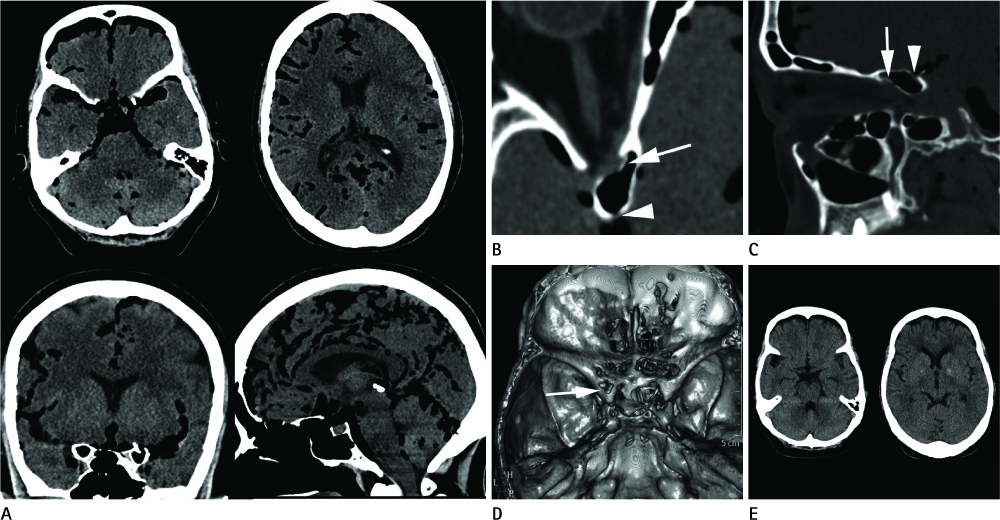J Korean Soc Radiol.
2011 Nov;65(5):447-450.
Massive Subarachnoid Pneumocephalus due to Transorbital Intracranial Penetrating Injury: A Case Report
- Affiliations
-
- 1Department of Radiology, College of Medicine, Chungbuk National University, Cheongju, Korea. lsyrad@chungbuk.ac.kr
Abstract
- A transorbital intracranial injury is a rare penetrating injury that can cause severe damage to orbital and cerebral structures. We report the case of a 53-year-old woman with massive subarachnoid pneumocephalus caused by a transorbital penetrating injury. She presented to our hospital with ocular pain after she accidently pierced her left eye with a steel wire while fixing a plant in a pot. A physical examination did not show any neurologic deficit. A brain CT showed a massive subarachnoid pneumocephalus with minimal intracranial hemorrhage and a 3D-reconstructed CT image showing a fracture at the pneumatized anterior clinoid process. A follow-up brain CT scan performed 10 days later revealed that the pneumocephalus and intracranial hemorrhage had completely resolved. The patient recovered without any complications.
MeSH Terms
Figure
Reference
-
1. Yildiz A, Duce MN, Ozer C, Apaydin FD, Eğilmez H, Kara E. Disseminated pneumocephalus secondary to an unusual facial trauma. Eur J Radiol. 2002; 42:65–68.2. Paiva WS, Monaco B, Prudente M, Soares MS, de Amorim RL, de Andrade AF, et al. Surgical treatment of a transorbital penetrating brain injury. Clin Ophthalmol. 2010; 4:1103–1105.3. Ha H, Kim YS, Seo JS, Lee WT. Homicidal transorbital intracranial injury by a metallic chopstick: a case report. Korean J Leg Med. 2007; 31:197–199.4. Turbin RE, Maxwell DN, Langer PD, Frohman LP, Hubbi B, Wolansky L, et al. Patterns of transorbital intracranial injury: a review and comparison of occult and non-occult cases. Surv Ophthalmol. 2006; 51:449–460.5. Kozikowski GP, Cohen SP. Lumbar puncture associated with pneumocephalus: report of a case. Anesth Analg. 2004; 98:524–526.6. Sherman SC, Bokhari F. Massive pneumocephalus after minimal head trauma. J Emerg Med. 2003; 25:319–320.7. Babl FE, Arnett AM, Barnett E, Brancato JC, Kharasch SJ, Janecka IP. Atraumatic pneumocephalus: a case report and review of the literature. Pediatr Emerg Care. 1999; 15:106–109.8. Yamashita T, Mikami T, Baba T, Minamida Y, Sugino T, Koyanagi I, et al. Transorbital intracranial penetrating injury from impaling on an earpick. J Neuroophthalmol. 2007; 27:48–49.9. Kim S, Lee JY, Song JS, Oh J. Transorbital-intracranial injury by a chopstick: three-dimensional computed tomography. Acta Ophthalmol Scand. 2005; 83:609–610.
- Full Text Links
- Actions
-
Cited
- CITED
-
- Close
- Share
- Similar articles
-
- Homicidal Transorbital Intracranial Injury by a Metallic Chopstick: a Case Report
- Fencing Knife-Induced Transorbital Penetrating Brain Injury: A Case Report
- Right-to-Left Displacement of an Airgun Lead Bullet after Transorbital Entry into the Skull Complicated by Posttraumatic Epilepsy : A Case Report
- Pneumocephalus due to Compressed Air Injury without Facial Bone Fracture
- Brain Abscess Following a Transorbital Penetrating Injury by a Wooden Stick: A Case Report


